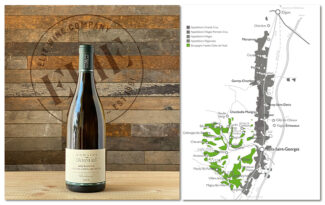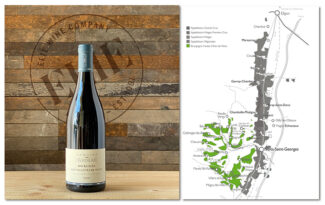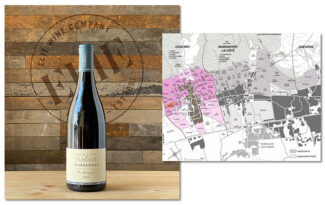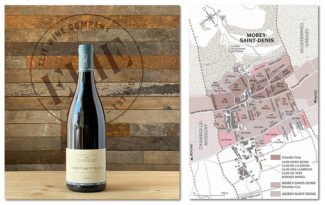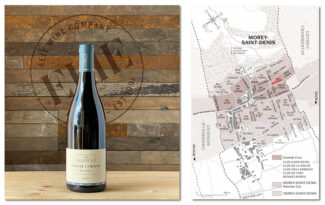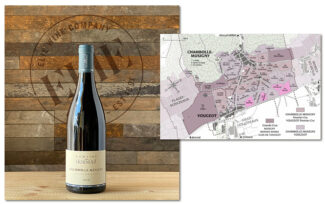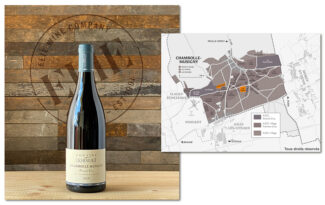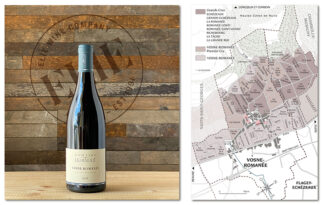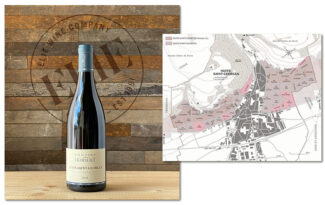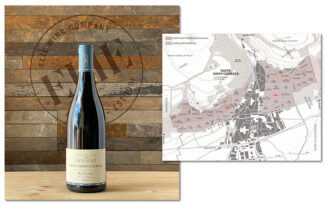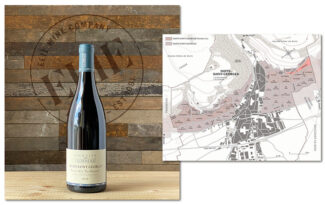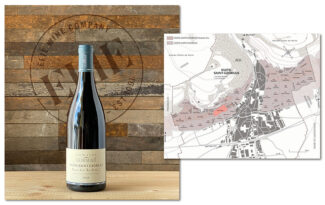Making Sense of Burgundy’s Côte de Nuits: End to End, Spanning Six Communes in Two-Dozen Parcels by Brothers Vincent and Philippe at Domaine Lécheneaut
‘Côte de Nuits’ is a name that excites the senses; it is mysterious (the name means ‘hills of the night’), it is sensuous (95% of its output is built around silk-smooth, hedonistic Pinot Noir) and it is evocative, with wine aromas frequently liked to roses and the spice-box. Hold a bottle of Côte de Nuits in your hands and you hold a key to a kingdom which produces the finest Pinot Noirs in the world. But the grape itself is a mystery within a mystery, and making sense of the individual styles and terroirs of the revered red wine vineyards of Côte de Nuits’ cannot be accomplished with a single bottle. Every village has its story and every vineyard its history; the wines vary by texture, color and dominant flavor notes.
As a primer to help isolate some of these characteristics, we have picked a top producer with small parcels in six of the most significant Côte-de-Nuits communes. It’s meant to be a general overview of the Côte de Nuits, but the heady sumptuousness of these wines is anything but generic.
The Notion of Terroir
The terroir of Côte de Nuits is built upon a pixel-like plan of vineyards that seems more like a maze than a map. Exposure is vital, and it’s said (tongue-in-cheek) that all the Grand Crus face Germany. The truth is, most of Burgundy is marginal grape country, and the farther north you go, the tougher it gets. But given the opposite conditions—compost-rich soil, plenty of sunshine and a long growing season with copious rainfall—you end up with happy vines that do not produce particularly complex wines. The stony soils of the Côte de Nuits’ Grand Crus excel chiefly because they are poor; the limestone bedrock offers abundant levels of elemental calcium, which helps open up the capillaries in the soil, increasing porosity and assisting root colonization. Stone fragments add to the drainage capability of the soil and reciprocally, these same fragments are a supplemental source of water that the roots can draw upon during times of shortage. Both water stress and water surplus can delay the onset of grape maturation, and the Grand Crus’ load of small, porous stones helps buffer the vine against both eventualities, favoring the early maturation of small-berried bunches. This unique set of conditions, when paired with the ideal elevation and topography, promotes maturity while beneficially increasing the ratio of skins to juice.
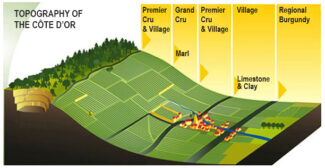
The Burgundian Landscape
The Côte de Nuits is the northern half of the escarpment of the Côte d’Or and is named after its principal town of Nuits-St-Georges. The most basic wines, produced mainly from grapes grown on the lower slopes of the escarpment, are labeled with a generic appellation such as Bourgogne Passtoutgrains (in which Pinot Noir may be legally blended with Gamay) or simply, Bourgogne.
The regional appellation of Bourgogne Hautes-Côtes de Nuits produces marginally superior reds from the higher slopes. A notch above these are the communal wines labeled Côtes de Nuits-Villages, produced in the smaller villages of Fixin, Brochon, Prémeaux, Comblanchien, and Corgoloin and the more prestigious village wines, which carry as their appellation the name of the village in which they were made. The principal villages of the Côte de Nuits, from north to south, are Marsannay, Fixin, Gevrey-Chambertin, Morey-St-Denis, Chambolle-Musigny, Vougeot, Vosne-Romanée, Flagey-Échezeaux, and Nuits-St-Georges.
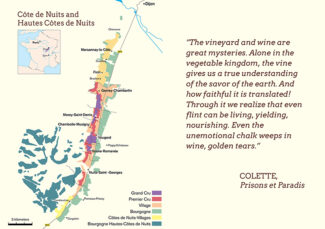
Vintage 2018: Fresh with Immediate Appeal
On the face of it, 2018 was straightforward and sublime; a wet winter and spring topped up the water reserves and a warm, sunny summer ensured the grapes reached phenolic ripeness without difficulty. The usual threats of disease, rot, frost and hail barely entered the picture, and harvest took place under blue skies inclement weather.
Two hailstorms in the southern part of Nuits-St Georges reduced crop, but for the most part, 2018 was an outstanding vintage that produced both early drinking examples and wines that will improve substantially with age.
Domaine Lécheneaut
Burgundian Sensibility
Having been founded in the 1950s by Fernand Lécheneaut, the domain launched modestly, with five acres of vineyard in Nuits-Saint-Georges, Chambolle-Musigny and Morey-Saint-Denis. During these early years, Lécheneaut sold bulk wine to négociants, but in 1985, his sons Philippe and Vincent took over and brought with them an expanded vision. They grew their vineyard holdings while they began to bottle at the estate. The new Lécheneaut plots, including several Premier Cru vineyards in Chambolle-Musigny and Gevrey-Chambertin, speckle the map of the Côte de Nuits from north to south, but judiciously—many of the holdings are under an acre. With vines in 23 appellations, the total land under their management is around thirty acres.
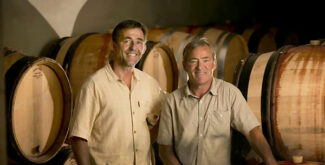
The Brothers Vincent and Philippe Lécheneaut
As the Lécheneaut brothers approach retirement, Vincent’s son Jules has joined the team with a view toward combining lessons learned in his experiences working vines in Oregon with the exceptional terroir his family nurtures.
The Burgundian Sensibility in the Vineyard – The essence of the terroir philosophy is that a given wine should demonstrate—through its weight, smell, taste and nuance—its place of birth. Failing to prepare for this goal even before the first root stock goes into the ground can compromise the results years down the line. In the vineyard, Burgundian sensibility is a practice that involves ecology, and soil—however vital—is only one part of that. Of equal importance is a thorough understanding of the site, and which clone will best mirror the available orientation, the local topography and the climate. Burgundian sensibility also extends to yields, which must be contained and limited to best reflect the characteristics of the grape. Above all, perhaps, is the sensibility born of experience in knowing when to pick; grapes at less than optimal ripeness make ‘green’ wines, but those sudden onslaught of rain that Burgundy is heir to may ruin the harvest of growers who chose to wait a single day too long. Ultimately, soil is destiny, and how the trace elements it contains translate into the glass are all part of man’s endless attempts to improve upon, while working in harmony with, nature.
The Burgundian Sensibility in the Winery – Once picked and delivered to the winery, a whole new stratum of sensibility develops. To stem or not to stem becomes a primary question; stems contain more tannin than grapes, and although tannin is frequently mentioned in gushing descriptions, too much results in an astringent mouthful and too little produces a wine than tastes thin and (since tannin is also a preservative) may not age long enough to reach its potential. Decisions on fermentation techniques now weigh in—whether to use commercial yeast or ambient, naturally occurring yeast fuels many a cellar debate. Either way, once fermentation has begun, it must be controlled, and in Burgundy—the home of high tech and low labor—it may be done by hand, with human beings immersing themselves in vats that have grown too cool for vigorous fermentation. Alternately, excessive heat—self-generated as a byproduct of fermentation, is of particular danger to delicate Pinot Noir. One technique to counteract heat is to add whole bunches of uncrushed grapes which have a cooling effect. You will see ‘whole bunch’ or ‘partial whole bunch’ on technical notes for precisely this reason.
Hautes-Côtes de Nuits: Firm & Straightforward, Middle-of-the-Road Temperament
Due west of Nuits-Saint-Georges, along southern half of a 12 mile stretch of vineland known as the ‘Champs-Élysées of the Bourgogne’, lies a lesser known wine region that is ripe for discovery. Once neglected by both growers and patrons, the area known as Hautes-Côtes de Nuits has enjoyed a viticultural renaissance in the past decade that has manifested terroirs similar to those in the heralded Côtes itself.
Overlooking the slopes of Gevrey-Chambertin and extending as far as the wood of Corton, the appellation was officially recognized in 1961 and covers 20 communes; 16 in the Hautes Côtes region in the département of Côte-d’Or, plus the higher areas of 4 communes in the Côte de Nuits where elevations average 1200 feet. Vines are planted alongsides of valleys that cut through the Jurassic limestone plateau to the west of the Côte; the underlying rock is the same as that of the Côte but the soil is thin or non-existent, formed by a mixture of eroded limestone and marly subsoil.
Domaine Lécheneaut, 2018 Bourgogne Hautes-Côtes de Nuits ‘Chardonnay’ ($48)
Situated on a hillside facing south at about 1150 feet, the vines cover the sloping valley cutting through the Jurassic chalky plateau, west of the Côte, a substrate is identical to that of the vine covered hillside, but the surface formations are very thin, at times non-existent. The chalky-clay soils are a result of the alteration of the limestone and marls substrate and are ideal for Chardonnay. The wine shows hawthorn and honeysuckle on the nose, which mingles on the palate with buttery apple, lemon, and hazelnut. Vines average 25 years old; 2100 bottles made.
*click on image for more info
Domaine Lécheneaut, 2018 Bourgogne Hautes-Côtes de Nuits ($48)
From a two-acre plot on the same Jurassic chalk plateau, from vines with an average age of 63 years. The wine is beautifully balanced, with aromas of raspberry, black cherry and licorice. Direct and firm flavors with granular, but well-integrated tannins. 7500 bottles made.
*click on image for more info
Marsannay: Smooth & Generous, a Meaty Wine
Referred to as the ‘Golden Gate to the Côte de Nuits’, Marsannay produces wine in all three chromatic styles—red, white and rosé—but the reds, in particular, are heralded for their richness, resembling in style the wines of neighbors Fixin and Gevrey-Chambertin. As an appellation, Marsannay encompasses the communes of Chenôve, Marsannay-la-Côte and Couchey.
The best vines are planted mid-slope with easterly or southerly exposures, and have historically been considered of only modest quality, with no Premier Cru—and certainly no Grand Cru—sites. However this issue has been under review in recent years, and two neighboring sites, Clos du Roy and Les Longeroies, gained Marsannay Premier Cru status in 2020.
Domaine Lécheneaut, 2018 Marsannay ‘Les Sampagny’ ($77)
‘Les Sampagny’ is a lieu-dit in the Couchey commune just north of Fixin and south of Marsannay; the soils are limestone and marl and the vines’ average age is 40 years. They produce a fruit-forward, openly-knit wine filled with crisp cherry, pie spice and a long, mineral-driven finish. 1500 bottles made.
*click on image for more info
Morey-Saint-Denis: Full & Powerful, Sings Tenor
Forming a stylistic bridge between the firm, fleshy wines of Gevrey-Chambertin and the perfumed wines of Chambolle-Musigny, Morey-Saint-Denis is a wealth of Crus, including twenty Premier Crus and five Grand Crus: Clos de Tart, Bonnes Mares, Clos de la Roche, Clos Saint-Denis and Clos des Lambrays. The best sites are planted on thin, well-drained, oolitic limestone soils that date from the Middle Jurassic, and occupy the middle slopes while lesser quality wines are produced on the highest and lowest elevations.
Even among Burgundy enthusiast, the Premier Cru climats are sometimes unfamiliar, due in part to the practice of blending of several vineyards as a generic Morey-Saint-Denis Premier Cru bottling, something that is somewhat more common here than in other communes.
Domaine Lécheneaut, 2018 Morey-Saint-Denis ($123)
A textbook Morey-Saint-Denis blend of parcels from Pierres Virants, En Seuvrey, The Cognées and The Porroux, where the vines are rooted in limestone and chalky-clay soils from the Jurassic period; Bathonien white oolite on the top of the hill and Bajocien chalky eutroques on the downslope. The wine is rich and assertive with Gevrey-Chambertin’s muscle and Chambolle-Musigny’s grace—its tone is suggestive of tart cherries, rose hips, violets and walnuts and fills out with stony persistence. 4200 bottles made.
*click on image for more info
Domaine Lécheneaut, 2018 Clos de la Roche Grand Cru ($475)
From a quarter-acre corner of the famous wall-enclosed ‘Clos de la Roche’ vineyard, where the vines are, on average, 60 years old. The vineyard sits above the Route des Grands Crus at an elevation of around 900 feet and is divided among eight climats. This wine in particular hails from Monts Luisants. De la Roche’s soils are only ten inches deep, but the aromas in the wine are soil-driven with blackcurrant, mocha, cinnamon and cherry throughout with an attractive sweetness and fine-grained tannins to finish. 500 bottles made.
*click on image for more info
Chambolle-Musigny: Elegant & Subtle, Regarded as ‘Feminine’
Chambolle-Musigny is tiny, but the village itself (with a population of 400 and an almost equal number of acres under cultivation) is in prime Pinot country—on the upper, well-drained mid-slope of the Côte d’Or escarpment at an altitude of around 1000 feet. The vineyards surround the village, stretching eastwards down the slope towards Bourgogne AOP zones and southwards to the edge of the neighboring village of Vougeot. Le Musigny and Les Petits Musigny extend further southwest in a corridor to the Premier Cru La Combe d’Orveau and the border with Flagey-Échezeaux while to the north lies Morey-Saint-Denis.
The output is small but the quality is prodigious; 24 Chambolle-Musigny Premier Cru sites cover 138 acres and two Grand Cru vineyards cover 59 acres.
Domaine Lécheneaut, 2018 Chambolle-Musigny ($123)
From a single acre site of 63-year-old vines across several Villages-level lieux-dits, Chardannes, Herbues, Maladières and Babillère. Most feature thin bedrock soils where cracks in the limestone encourage root exploration, and ensure a marvelous complexity. The bouquet of violets and rose petals introduces a wine which is beginning to age into spicy maturity with prunes and truffles and a palate that has evolved with rich, silken tannins. 2400 bottles made.
*click on image for more info
Domaine Lécheneaut, 2018 Chambolle-Musigny Premier Cru ($211)
A tiny plot (smaller than a quarter-acre) of 70-year-old vines in ‘Les Plantes’ and ‘Les Borniques.’ These lieux-dits are located on the alluvial cone of the Ambin valley and the substratum is composed of Periglacial red silt enriched with breccias of the Bathonian limestone that forms the plateau. Sophisticated and elegant, the wine presents rich aromas of blackberry, blueberry, redcurrant and ripe plum which over time should develop into leather, chocolate and pepper notes. 1000 bottles made.
*click on image for more info
Vosne-Romanée: Full-Bodied & Voluptuous, A Ruben’s Nude
There are few wine communes in the world as hallowed as Vosne-Romanée; the village has been a known source of quality wines since the arrival of the monks of the Saint-Vivant monastery more than a thousand years ago. Today, it makes wine almost exclusively from Pinot Noir, although up to 15 percent of the local white varieties are permitted to allow for natural planting variations and mutations. Originally named just Vosne, the village took the suffix Romanée in 1866 in honor of its most prized vineyard, La Romanée.
Nowhere is terroir more microscopically defined; Vosne-Romanée’s best vineyards lie just above the village on the mid-slope. Around these prestigious Grand Cru sites are dotted the Vosne-Romanée Premier Cru vineyards along with some entirely unclassified land. The difference between a Grand Cru vine and one deemed worthy only of a regional Bourgogne appellation is sometimes a matter of a few feet.
Domaine Lécheneaut, 2018 Vosne-Romanée ($123)
From the lieu-dit Aux Ravioles, located on the bottom of the hill on lightly chalky soils mixed with marl and clay. It is an opulent and fleshy wine with notes of brandy-soaked cherries and vibrant, concentrated raspberries with elegant undertones of earth and graphite. 2400 bottles made.
*click on image for more info
Nuits-Saint-Georges: Muscular & Vigorous, Sturdy Character
With the village of Nuits-St-Georges itself as the fulcrum, the robust appellation extends to the north as far as the border of Vosne-Romanée, while the southern section lies partly in Nuits-Saint-Georges and partly in Prémeaux. The wines from each section are unique in style and according to experts, with differences defined (in the main) by the lay of the land. The soils in the northern sector are built around the pebbly alluvium that washes down from up-slope, or in the low-lying parts, around silty deposits from the river Meuzin. In the southern sector the alluvia at the base of the slopes originate in the combe of Vallerots where there are deep marly-limestone soils, while at the top of the slope, the soil has nearly all eroded away and the rock is near the surface. In both regions, favored exposures are mostly to the east or southeast.
Domaine Lécheneaut, 2018 Nuits-Saint-Georges ($105)
A blend from seven parcels, Damodes, Saint Jacques, Herbues, Tuyaux, Belles Croix, Charmois and Chaliots where terroirs vary with the north-to-south orientation—the soils from the northern parcels contain silt and gravel from the alluvial Meuzin valley and in southern parcels, silts originate from the Combe des Vallerots. Fragrant notes of dried flowers and bright red currant lead to a smooth palate filled with crunchy cherry flavors and a mineral-driven core. 7500 bottles made.
*click on image for more info
Domaine Lécheneaut ‘Vieilles Vignes’, 2018 Nuits-Saint-Georges ‘Au Chouillet’ ($123)
The ‘Au Chouillat’ lieu-dit features 70-year-old vines planted in marl formations covered by clay and red silt deposited from ancient alluvial cones and sediments from the valley of Meuzin—the river that divides the Nuits vineyards into its north and south zones. Hints of creamy oak and forward cherry with undertones of Kirsch and a soft lift of smoke. 4200 bottles made.
*click on image for more info
Domaine Lécheneaut, 2018 Nuits-Saint-Georges Premier Cru – Les Damodes ($176)
‘Les Damodes’ makes reference to the Druidesses who previously inhabited the area. These vines are planted with a southeasterly aspect and at high altitudes bordering Vosne-Romanée. For Domaine Lécheneaut, the lieu-dit represents about an acre’s worth of brown calcareous soils, fine gravel, silty-clay and reddish rubble. A detailed, elegant wine with smoky cherry, lacy spice and herb aromas above licorice and violet. 3000 bottles made.
*click on image for more info
Domaine Lécheneaut, 2018 Nuits-Saint-Georges Premier Cru – Les Pruliers ($176)
‘Les Pruliers’ is located just a few hundred meters to the southwest of the Nuits-Saint-Georges commune. Its relative proximity to the Meuzin River means there is a greater percentage of clay in the soils than in the Premier Cru plots further to the south towards Beaune. Though there is more gravel in the southern part of the plot, overall this gives Les Pruliers wines greater body. The bouquet evokes wild plums as well as notes of licorice and spiced roses, and as the wine matures aromas of cocoa, smoked meat, and undergrowth arise and smooth out the generous structure. 2700 bottles made.
*click on image for more info
- - -
Posted on 2022.09.08 in Chambolle-Musigny, Hautes-Côtes de Nuits, Côte de Nuits, Morey-Saint-Denis, Premeaux-Prissey, Premeaux-Prissey, Nuits-Saint-Georges, Marsannay, Gevrey-Chambertin, France, Burgundy
Featured Wines
- Notebook: A’Boudt Town
- Saturday Sips Wines
- Saturday Sips Review Club
- The Champagne Society
- Wine-Aid Packages
Wine Regions
Grape Varieties
Aglianico, Albarino, Albarín Blanco, Albarín Tinto, Albillo, Aleatico, Arbanne, Aubun, Barbarossa, barbera, Beaune, Biancu Gentile, bourboulenc, Cabernet Franc, Cabernet Sauvignon, Caino, Caladoc, Calvi, Carcajolu-Neru, Carignan, Chablis, Chardonnay, Chasselas, Clairette, Corvina, Cot, Counoise, Erbamat, Ferrol, Fiano, Frappato, Friulano, Fromenteau, Fumin, Garnacha, Gewurztraminer, Godello, Graciano, Grenache, Grolleau, Groppello, Juan Garcia, Lambrusco, Loureira, Macabeo, Macabou, Malvasia, Malvasia Nera, Marsanne, Marselan, Marzemino, Melon de Bourgogne, Merlot, Mondeuse, Montanaccia, Montepulciano, Morescola, Morescono, Moscatell, Muscadelle, Muscat, Natural, Nero d'Avola, Parellada, Patrimonio, Petit Meslier, Petit Verdot, Pineau d'Aunis, Pinot Auxerrois, Pinot Blanc, Pinot Gris, Pinot Meunier, Pinot Noir, Poulsard, Prieto Picudo, Rondinella, Rousanne, Roussanne, Sangiovese, Sauvignon Blanc, Savignin, Semillon, Souson, Sparkling, Sumoll, Sylvaner, Syrah, Tannat, Tempranillo, Trebbiano, Trebbiano Valtenesi, Treixadura, Trousseau, Ugni Blanc, vaccarèse, Verdicchio, Vermentino, Viognier, Viura, Xarel-loWines & Events by Date
- April 2024
- March 2024
- February 2024
- January 2024
- December 2023
- November 2023
- October 2023
- September 2023
- August 2023
- July 2023
- June 2023
- May 2023
- April 2023
- March 2023
- February 2023
- January 2023
- December 2022
- November 2022
- October 2022
- September 2022
- August 2022
- July 2022
- June 2022
- May 2022
- April 2022
- March 2022
- February 2022
- January 2022
- December 2021
- November 2021
- October 2021
- September 2021
- August 2021
- July 2021
- June 2021
- May 2021
- April 2021
- March 2021
- February 2021
- January 2021
- December 2020
- November 2020
- October 2020
- September 2020
- August 2020
- July 2020
- June 2020
- May 2020
- April 2020
- March 2020
- February 2020
- January 2020
- December 2019
- November 2019
- October 2019
- September 2019
- August 2019
- July 2019
- June 2019
- May 2019
- April 2019
- March 2019
- February 2019
- January 2019
- December 2018
- November 2018
- October 2018
- September 2018
- August 2018
- July 2018
- June 2018
- May 2018
- April 2018
- March 2018
- February 2018
- January 2018
- December 2017
- November 2017
- October 2017
- September 2017
- August 2017
- July 2017
- June 2017
- May 2017
- April 2017
- March 2017
- February 2017
- January 2017
- December 2016
- November 2016
- October 2016
- September 2016
- August 2016
- July 2016
- June 2016
- May 2016
- April 2016
- March 2016
- February 2016
- January 2016
- December 2015
- November 2015
- October 2015
- September 2015
- August 2015
- July 2015
- June 2015
- May 2015
- April 2015
- March 2015
- February 2015
- January 2015
- December 2014
- November 2014
- October 2014
- September 2014
- August 2014
- July 2014
- June 2014
- April 2014
- March 2014
- February 2014
- January 2014
- December 2013
- November 2013
- October 2013
- September 2013
- August 2013
- July 2013
- June 2013
- May 2013
- April 2013
- March 2013
- February 2013
- January 2013
- December 2012
- November 2012
- October 2012
- February 2004
Search


